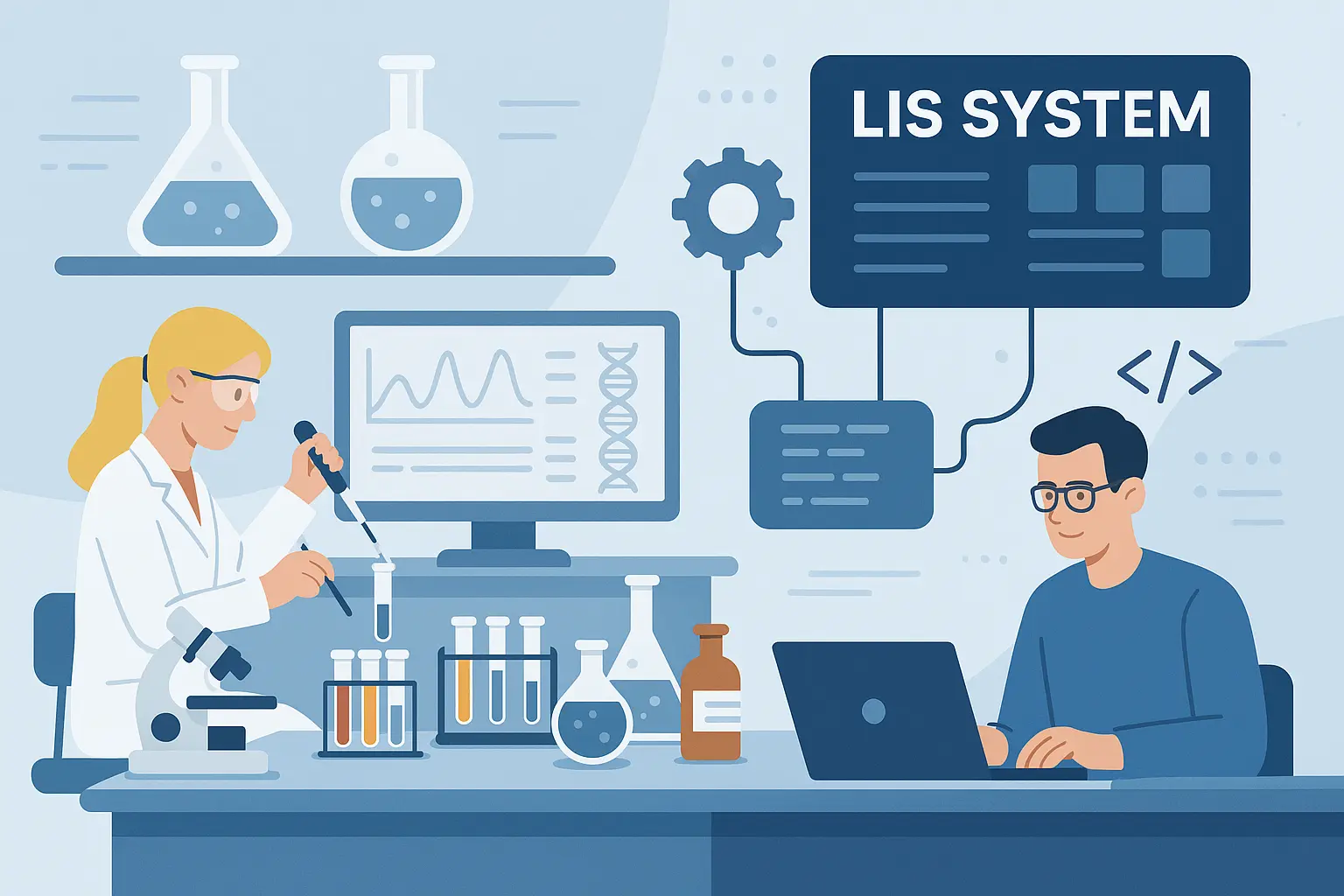Blog
Optimizing Lab Workflow
April 14, 2025
Working in a clinical lab or within a pathology practice - where precise data collection and effective laboratory workflow management are necessary to function - can be complicated because multiple employees typically have several different daily lab processes. The way to counter this is by streamlining and incorporating activities into a daily lab workflow cycle as part of comprehensive pathology lab management.
What is Laboratory Workflow Management?
The easiest way to think of laboratory workflow management is as a checklist or flowchart of procedures that accounts for every technician in the room and every task going through the laboratory to maintain order.
Lab workflow management typically includes LIS laboratory information system technology that aligns with standard operating procedures (SOPs) and helps improve overall workflow efficiency.
Learn More: Mastering Lab Operations - A Guide to Clinical Laboratory Management Solutions

The Best Laboratory Information System Software and Lab Workflow
Next, let’s examine the role of laboratory information systems and how the best LIS supports modern lab workflow.
The best laboratory information system software (medical LIS) can expertly manage all patient information, including personal data, lab test results, and other essential clinical examination data that need sorting and storing.
LIS software is a formal tool used to streamline this laboratory workflow management process as it reduces unwanted errors resulting from the tedious manual recording/processing of patient and specimen data.
Laboratory information systems (also known as pathology lab software solutions) help oversee clinical lab workflow by supporting sample tracking, laboratory testing workflow, workflow process improvement, and lab workflow optimization, among many other critical operational tasks.
Using an efficient, all-encompassing LIS lab workflow platform that is compatible with the needs of the clinical laboratory helps automate core processes and monitor lab samples and test results. This positions lab personnel and LIS lab staff to produce fast, accurate clinical results while heightening patient safety.
Learn More: Best LIS Software - Maximize Growth With Cutting Edge Pathology Lab Management Software
Laboratory Workflow Management and the Digital Pathology Workflow
Effective laboratory workflow management also makes it easier to work on virtual microscopy. Digital pathology solutions facilitate the acquisition, management, and interpretation of pathology information in a non-traditional way - through the use of digitized slides viewed on a monitor rather than the use of glass slides viewed under a microscope.
Digital pathology workflow helps pathologists follow patterns and tag outliers. Its images can easily be transported from one clinical setting to another, improving lab efficiency and diagnosis turnaround time.
As the sanctity of a clinical examination is in the repetition and continuous logging of records, having an effective laboratory workflow management system in place assures that each team member knows the processes they are responsible for and can collectively work together to properly test the sample and identify and report on the result of the testing procedure.
On-Demand Webinar: Utilizing Digital Pathology to Help Offset Today’s Laboratory Challenges

Laboratory Workflow Management and Laboratory Information System Companies
Laboratory workflow management can be challenging as organizations need to be guided by Standard Operating Procedures and the Health Information Privacy Protection Act (HIPAA). This legislation ensures security for the public within three areas of data storage: technical security, administration, and the physical storage of protected information.
Clinical healthcare facilities (pathology labs, clinics, hospital systems, etc.) must adhere to all three. A manageable, searchable, and auditable laboratory information system supported by an innovative LIS company is crucial to maintaining this security.
One way clinical labs - and all medical laboratories - can streamline processes is by planning for solutions with laboratory information system vendors.
Troubleshooting guidance for common issues or abnormalities should be built into the LIS system, giving all lab personnel quick access to the information they need without delays or jeopardizing sample integrity.
In addition, the lab information system should document any unexpected problems as they occur, creating a valuable record for process improvement and accountability.
The chosen medical LIS must be a refined, reliable system that supports pathologists and lab professionals in delivering accurate results quickly, ultimately improving patient care.
Learn More: The Best Laboratory Information System Companies and the Advantages They Offer to Their Laboratory Clients
How to Improve Laboratory Workflow Management
Here are some tips to help improve laboratory workflow management. Most of these would be more achievable with the best LIS medical solution backed by the best LIS software vendors.
They are as follows:
Helpful Tips
Identify Bottlenecks - Does a procedure constantly bottleneck at the same point? Is the pattern notable but unverifiable because of a lack of recorded data? Learn where and why this challenge is occurring and address the problem.
Do Tasks Simultaneously - An example is the speed at which the world was given a proven COVID-19 vaccine. This is because processes that didn’t have to wait for one another were completed in parallel. Do whatever the lab can do alone or in concert with other parts of the clinic to cut down on procedural time.
Develop a Continuous Flow Process - Instead of batching or waiting until a group of tests is ready to be handled, develop a continuous flow process. This can help patients obtain answers faster and encourage employees to diversify their workday.
Industry Insights: Just-In-Time vs. Batch Processing in the Medical Lab: Examining the Pros and Cons
Why Use Laboratory Workflow Management Software?
Laboratory workflow management software, such as a laboratory information system, is a branch that needs to be addressed to achieve optimized lab efficiency and productivity.
Extended pathology lab management includes laboratory billing (lab revenue cycle management) and digital pathology solutions, evaluation and workflow improvement, employee continuing education, and laboratory updates in compliance oversight.
Laboratory workflow management also incorporates supplies, schedules, record keeping, documentation, and reporting of lab status and other activities. Process control is an essential part of clinical laboratory management, and this is where effective lab workflow solutions come in.
The role of a reliable lab information system (modern diagnostic lab software) working within a shared database ensures that all components of lab workflow management are supervised and running smoothly. Elements like automation and multi-department operational guidelines are essential to improve the laboratory workflow process and data and sample management procedures.
Laboratory workflow examples of struggles with their chosen pathology lab software tool involve lack of technical support, incomplete features, non-workable interfaces, missing or untracked patient and sample records, difficulty accessing the database, and so on.
An agile, comprehensive, and future-ready LIS software solution will help alleviate these lab management challenges and help build the business by removing barriers that will allow it to scale up.
Learn More: How to Turn Your Mid-Sized Medical Laboratory into a Thriving Large-Scale Operation

Final Word on Optimizing Laboratory Workflow Management
Improving efficiency and ease of use within the laboratory workflow is essential for optimizing operations. Effective laboratory workflow management should account for standard operating procedures (SOPs), current practices, and quality control protocols.
With so many interconnected processes, implementing a robust workflow management system - powered by a modern laboratory information system software - can significantly enhance the speed and capacity of lab operations.
The best LIS streamline data and simplify access to archived information while supporting ongoing research efforts. More importantly, advanced LIS software drives higher productivity and elevates the quality of laboratory services. Whether it’s expanding test offerings or increasing testing volumes, a well-optimized LIS-driven workflow enables labs to improve accuracy, scale efficiently, and adapt to the evolving demands of healthcare.
Learn More: Pathology Lab Software - Determining Which LIS System is the Best Fit for Your Laboratory






